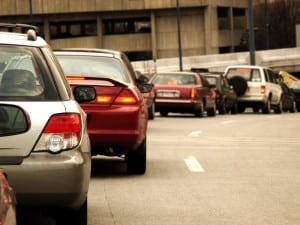A long-awaited Baker administration study of Massachusetts’ sclerotic transportation network did not fully endorse a method backed by many transit advocates to toll highways based on demand, but recommended a more limited form restricted to specific highway lanes.
MassDOT released its report in a press conference Tuesday morning attended by Gov. Charlie Baker, Lt. Gov. Karyn Polito and Transportation Secretary Stephanie Pollack.
The report quantified levels of congestion and recent trends for specific locations, analyzed the problem’s causes and recommended solutions ranging from transit improvements to more telecommuting to conducting a feasibility study of congestion pricing using managed lanes.
“Traffic and congestion are a nuisance for too many residents, and this report provides our administration with robust data to help us make informed decisions on how to build on our efforts to tackle the commonwealth’s congestion issues,” Baker said in a statement. “From this report, we have identified several ways to address congestion by expanding capacity on our transit system, adding more housing, and exploring managed lanes to help make people’s commutes be more reliable. We look forward to working with the Legislature, local government and the private sector to develop solutions to reduce the variability in people’s commutes.”
Among the report’s key recommendations:
- “Actively manage” state and local roadway operations
- Reinvent bus transit at both the MBTA and Regional Transit Authorities
- Increase MBTA capacity and ridership
- Work with employers to give commuters more options, including providing grants for employers, transit management associations, regional transit authorities and others to provide new workforce transit options to employees
- Increase remote work and telecommuting
- Produce more affordable housing, especially near transit
- Encourage growth in less-congested Gateway Cities
- Investigate the feasibility of congestion pricing mechanisms including tolled HOV lane-like “managed lanes”
The report defines these managed lanes as a system of parallel lanes on a road, with one or more lanes for drivers that remain free to use while one or more lanes require drivers to pay a fee, which may be constant or vary depending on congestion levels. Managed lanes could also be used by carpools, buses and vans carrying large amounts of people for no cost, allowing more people to travel in a faster lane with less congestion and no congestion fees.
“We cannot eliminate congestion entirely, but we can better manage it to make trips more reliable and predictable,” Pollack said in a statement. “That includes new initiatives as well as a greater emphasis on practices already in use, such as traffic systems management operations (TSMO) practices that have been used in Massachusetts for years. Moving forward, managing roadways through a TSMO framework must become as much a part of MassDOT’s DNA as fixing potholes and plowing snow. Advancing, expanding and institutionalizing these kinds of solutions will help limit the effects of crashes, work zones and weather on already lengthy commutes.”
The report found the five most congested spots in the state:
- Interstate 93 southbound from Mystic Valley Parkway in Medford to McGrath Highway in Somerville at 7 a.m.
- Route 2 eastbound approaching Alewife Station at 8 a.m.
- I-93 northbound from the Braintree Split to Neponset Circle at 7 a.m.
- Route 2 eastbound approaching Alewife Station at 7 a.m.
- I-93 southbound from Mystic Valley Parkway in Medford to McGrath Highway in Somerville at 8 a.m.
Additional data identified several corridors in the state with segments that are congested for more than 10 hours per day. Nine roadway segments each see more than 10 hours per day of congested or highly congested conditions: Route 1A southbound in Revere, American Legion Highway, (Route 60), in Revere, O’Brien and McGrath highways northbound from Leverett Circle to Mystic Valley Parkway, the Fellsway and Main Street southbound from Reading to Medford, the Sagamore Bridge, Fresh Pond Parkway in Cambridge and I-93, from Boston to New Hampshire, running along the Central Artery portion, the Southeast Expressway segment and a segment that partially carries the I-95/128 designation.
While congestion is not as persistently severe outside of Greater Boston, the report found, it is nonetheless a source of frustration for drivers who travel along Route 9, Route 7, Interstate 91, Interstate 290, or some western portions of the Mass. Pike during peak commuting periods.




 |
| 


